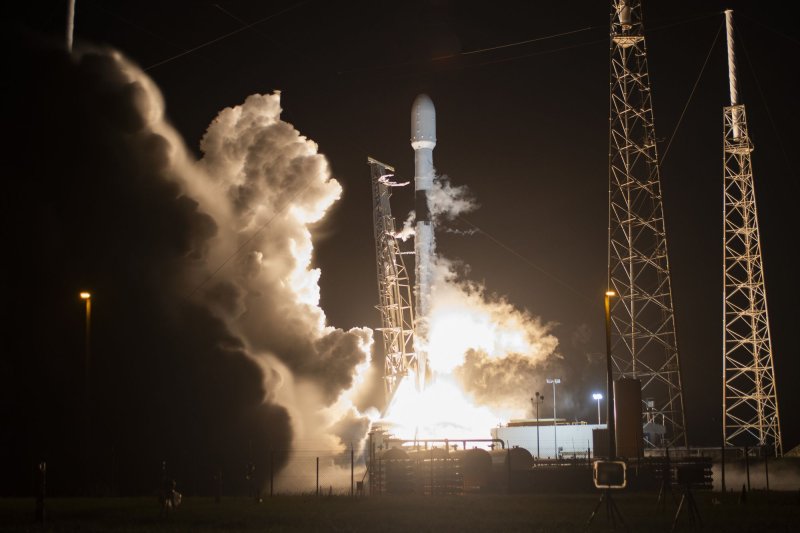1 of 4 | A SpaceX Falcon 9 rocket boosts the company's Starlink satellites to orbit Wednesday from the Cape Canaveral Air Force Station. Photo by Joe Marino/UPI |
License Photo
ORLANDO, Fla., June 3 (UPI) -- A SpaceX Falcon 9 rocket lifted off on time Wednesday night from Cape Canaveral Air Force Station in Florida, propelling 60 Starlink communications satellites into orbit.
The successful launch boosted the number of Starlink satellites circling the Earth to 480, by far the greatest number of any communications network.
Liftoff at 9:25 p.m. EDT came on a warm, humid night after skies cleared sufficiently to ensure a safe launch and adequate monitoring.
At about 2 minutes, 45 seconds after launch, the nine main engines of the rocket's first stage shut off, and that stage re-entered the Earth's atmosphere for recovery off Florida on the SpaceX barge named Just Read the Instructions.
The first stage landed mostly inside a bull's-eye on the flat deck.
The second stage carried the satellites into orbit successfully, SpaceX engineers said. Video showed the Starlink cluster deploying roughly 15 minutes after liftoff.
The size of the Starlink constellation already is large enough for "minor" internet coverage around the world, according to SpaceX founder Elon Musk's statements to the press before the first Starlink launch in 2019.
But SpaceX hasn't released more information about the network's operation or its intended customers.
Starlink aims to provide next-generation broadband internet service to the globe, outpacing that offered by such players as Iridium or Intelsat. SpaceX said in 2019 it aimed to launch 1,600 satellites in the first phase.
At that point, the satellites would transmit data to each other via laser pulses through the vacuum of space -- a far faster method than even fiber optic cables on Earth.
Starlink, which the company said could cost $10 billion to develop and launch, has boosted the value of SpaceX and its recent rounds of investment, according to stock analysts and SpaceX's filings with the Securities and Exchange Commission.
SpaceX raised $567 million, according to the commission documents filed in the last few months.
"We are modeling for $10 billion to $15 billion from 2020-2025 for Starlink, with the potential for more from ground terminals, 30,000 additional satellites and replacement of satellites" and other SpaceX endeavors, according to a recent note from analysts at Morgan Stanley.
Starlink also would owe some of its speed to its much lower orbit than previous communication satellite networks -- 340 miles up.
By comparison, Iridium satellites are about 485 miles up. The Kármán line that defines space is 62 miles high, and the International Space Station is more than 250 miles high.
On this mission, SpaceX was to launch the first Starlink satellite with a visor to block sunlight from hitting the brightest spots of the spacecraft. Musk announced April 27 that the sunshade, which he called a VisorSat, would be included in the next Starlink launch.
VisorSat is designed to prevent the satellites from reflecting sunlight back to the Earth, which can interrupt astronomy observations.
This was the second Starlink launch during restrictions on access to the Air Force station due to the coronavirus pandemic. The launch also came on the heels of Saturday's successful SpaceX launch of the first flight of NASA astronauts from U.S. soil since 2011.
The space firm previously launched 60 Starlink satellites at a time in May, November, on Jan. 6 and 29, Feb. 17, March 18 and April 22, with two test satellites launched before that.
The first-stage booster for this launch previously flew four times, including the launch of an Iridium satellite in January 2019, and two separate Starlink missions in May 2019 and January 2020.
NASA astronaut Douglas Hurley (C) waves to onlookers as he boards a plane at Naval Air Station Pensacola to return him and NASA astronaut Robert Behnken home to Houston a few hours after the duo landed in their SpaceX Crew Dragon Endeavour spacecraft off the coast of Pensacola, Fla,, on August 2, 2020. Photo by Bill Ingalls/NASA |
License Photo
















